ONLY PROPAGANDA? REFLECTIONS ON AN INVASION

Photo Source: Antonino Rampulla
I write this third post on the war in Ukraine as a pretext for my personal need to investigate, to understand an event after which the world will certainly be, in one way or another, radically different. The difficulty, ever since concrete winds of war began to blow last year, has been trying to intercept the most "objective" information possible. The metaphor is the recent Bucha massacre : not only do the Russians deny that their armed forces are responsible but even claim that it is all Ukrainian (and Western) hype to discredit them. Putin's "special operation" would have been triggered at the request of the Russian speakers of the Donbass, with respect to whom Kiev, since 2014, would have even planned a genocide: at this point I would rather tend to believe the OSCE observers, of whom I have already written in a previous post, whose narrative is substantially different. If we wanted to follow the hypothesis of the western hype of the Bucha massacre, at the moment in which Putin seems only to recognize the reasons for the force, making a mockery of the United Nations itself, not retreating from the justificatory framework of his "special operation" as a due and inevitable against a Ukraine that should only surrender and accept its conditions, what good is organizing a film set in full war to accuse Moscow? To push NATO (which immediately, in its ambiguity, was it clear that he would never wage war on Russia to defend a non-member country) to "finally" enter a nuclear conflict with Moscow?
Western public opinion is now essentially divided into two:
1. Yes to economic aid and to sending arms to Ukrainians and, therefore, yes to sanctions against Russia;
2. No to military support for Ukraine, to hitting Russia too harshly through sanctions and, therefore, no to exasperating the conflict.
For the former, the fear is that leaving the field open to Russia, apart from decreeing the death of Ukraine, would justify the ambitions of anyone else or even Russia itself to act towards other states in a similar manner. For the latter it is that the prolongation of the Ukrainian resistance could lead to the Third World War, obviously nuclear.
Below I deal with the issues that I most seemed to recognize in the daily confrontation between facts and opinions on this war.
1. NATO threats to Moscow
NATO is a defensive alliance, at least on paper, which has actually intervened very few times since its constitution. It would therefore be good not to confuse the initiatives of the United States with those of the Atlantic Alliance, although it is self-evident that the United States is the member with the greatest political weight and military contribution, which therefore exerts such influence as to substantially coincide national interests with those of NATO. Not surprisingly, in this period there is a debate in the Italian Parliament on whether to increase military spending to 2% of GDP, as the United States has been asking for some time in order to balance the burdens of the Alliance a little better.
Ukraine has applied to join the NATO in 2008: to date, therefore, Ukraine is not part of NATO , therefore it has never hosted NATO missile systems on its territory which, among other things, , would only have a declared defensive purpose with respect to ballistic missiles (ie anti-ballistic-missile missiles). Putin's substantial casus belli is that NATO could deploy offensive missiles in Ukraine . The most similar historical precedent in the background (the Cuban crisis) was resolved more or less diplomatically (proof of this is the fact that we are here to talk about it ...).
Repetita iuvant: Ukraine is not part of NATO and has never hosted ballistic missiles aimed at Moscow.
So what, in relation to NATO, would have made Putin decide to invade Ukraine?
NATO (or simply some of its members), on several occasions, at least since 2004, has carried out exercises in Ukraine: since the invasion of Crimea, clearly, relations between NATO and the Russian Federation have begun to crack and, probably, in the last years the exercises on Ukrainian territory were perceived by Putin as a threat . But so much to risk a nuclear conflict?
Looking outside Ukraine, US meddling in the Syrian civil war in support of anti-government forces and Kurds may have been seen by Russia, a supporter instead of Assad, as a direct threat to some NATO members. In any case, Assad remained in power thanks largely to Russian support. Can it therefore be considered a victory for Putin?
In the heart of the Syrian crisis, men three the United States supported the Kurds against Assad, Turkey, another NATO member, bought S-400 missiles from Russia, to be used against the Kurds allies of the Americans, whom Erdogan and his associates consider instead terrorists. As a response, the United States ousted the Turkish allies from the F-35 fighter program but, finally, they "unloaded" the Kurds to safeguard the much more powerful Turkish ally ... Italy itself, for its part, seems to have sold , circumventing the embargo imposed by NATO on the Russians in 2014, military vehicles on Russia.
In short, in relation to the invasion of Ukraine, could Putin have taken advantage of the relative instability of the Atlantic Alliance? Thus betting that NATO would not actively intervene to help the Ukrainians?
So, that the alleged NATO threats were just a pretext?
In retrospect, it is a fact that NATO is not intervening (and unlikely to intervene) . 2. Illegal wars
Saddam Hussein's dictatorial regime had long since taken an obviously intolerable turn in US foreign policy, so that in 2003, wanting to give credit to the shaky statements of the Iraqi engineer Janabi (whose personal desire was the ousting of the dictator, with all means, even with lies), regarding the notorious chemical weapons illegally held by the regime, attacked and invaded Iraq without a UN mandate (the legitimacy of that military operation is in fact still a debated topic). Saddam Hussein's regime was later replaced with a "friendly" government.
The Ukrainian orange revolution in 2004 initiated a process of political rapprochement with the European Union, interrupted only by the pro-Russian parenthesis of the Yanukovyc government. Putin’s Russia thus sees the plan to include Ukraine in its political and economic sphere of influence fading. So in 2014 he takes possession of Crimea and in 2022, under the pretext of liberating the "Russian" republics of Donetsk and Lugansk and of "denazifying it", invades Ukraine without a UN mandate .
It is clear that the European perception, heir to the cultural evolution that from the mythicized experience of the democratic polies has passed through the Enlightenment reflection up to the liberal forms of government that distinguish much of the Western world, tends to consider "bad" the dictator who invades the "good" democratic state.
However, countries such as India, Pakistan, Iran, China itself, did not adhere to the resolution condemning the Russian invasion of Ukraine by the United Nations. In other words, a good chunk of the world's population is likely to view the US Democrats as the bad guy instead. In short, the presumed moral superiority of the West would be relative.
In this regard, the reflection of prof. Orsini on the fact that the great powers have always attached little importance to ideology . The important thing, that is, is not that other countries share the same political ideology but that they have a foreign policy that is favorable to them. In fact, for example, the United States has supported regimes that have not even had the appearance of a democrat. In other words, ideological rhetoric is not substantial, but only formal and serves to justify interference in internal issues of other countries that have political interests incompatible with their own. So, just as the United States overthrew Saddam Hussein when it could no longer control him (whose rise to power they initially supported and financed), so would Putin do towards Zelensky.
3. Neutrality
Putin, however, does not seem to want Ukraine in NATO . NATO, especially in order not to exacerbate relations with Russia, in turn does not want Ukraine. Ukraine therefore can only take note of it and renounce eventual membership of NATO, with all due respect to all democratic principles and self-determination .
The conditio sine qua non for peace, in fact, passes precisely from the Finlandization of Ukraine, that is, from its neutrality (even if it seems that Finland itself, fearing the Russians, is about to join the Atlantic Alliance…)
However, for Putin, Ukraine can, if it wants, join the European Union . It seems to fall back to seventy years ago, when in Yalta the two superpowers, in fact, divided the world ...
It does not seem necessary to have to squeeze too hard to deduce that the problem, for Putin, is therefore not NATO per se (and even less Ukraine) but the United States of America ...
In addition to not wanting, therefore, the Americans behind the front door, Putin wants the recognition of Crimea as Russian territory, the independence of the republics of Donetsk and Lugansk (to be incorporated later, probably, in the Russian Federation), the demilitarization of this that would remain of Ukraine and the obvious change of regime (sorry ... "denazification"). 4. Is Ukraine willing to sacrifice itself for "peace"?
NATO has certainly done wrong with Ukraine: making it believe it would defend it in the event of a Russian attack . The first signs were revealed with the ambiguity of Biden's distinction between "minor incursions" and "invasion", for which NATO would have intervened only in the second hypothesis. However, the nature of the intervention was never specified ...
To Putin's revisionist rhetoric, which seems to deny Ukraine the status of a sovereign state, considering it a sort of Russian province that has found itself feignedly autonomous due to a strange joke in history (therefore destined to end), alongside the pragmatism of prof. Orsini, for whom it is necessary to acknowledge as soon as possible and with conviction that, with the ongoing invasion, Ukraine is preparing to become Russian de facto . Basically, the more the Russian armed forces advance, the more the reasons of force prevail over the normative ones: should the Ukrainians therefore declare themselves defeated to minimize further destruction and loss of life, fully accepting Putin's demands? . To this end, it would therefore be counterproductive to consider Putin, as in essence Biden does, the new Hitler but one should simply consider him a head of state who aims to safeguard the political and economic interests of his own nation. It is therefore necessary to understand the reasons that led Putin to embark on a war, in order to identify the most effective alternatives to protect the Ukrainian population with respect to the answers contemplated so far.
The "problem" is that Ukrainians do not seem willing to give up and sacrifice themselves for the peace and stability of the rest of the world. Indeed, they are convinced that they are fighting against a tyranny that sooner or later would strike down against other states, in the very heart of Europe.
Obviously not everything is black or white, and the Ukrainian fathers and husbands, probably forced (even by force) to leave their wives and children on the border with Poland to return to fight in defense of the homeland, are paired with the many Russian deserters, jumped suddenly and without warning from a drill to an invasion.
5. Only anti-Russian propaganda?
What credibility can the Russian government therefore have which, until a few days before invading Ukraine, accused the United States of spreading fake news about the imminent invasion (which according to the Kremlin were just hysterical American fantasies )? It is questionable whether the fears of the Baltic countries, Moldova or Poland, regarding Putin's assurances, are well founded? For example, on March 4 Putin declared that his Belarusian friends would like an outlet in the sea…
In addition, like Ukraine, Georgia and Moldova also hosted NATO exercises and asked to join. And as in Ukraine, the Russians have "encouraged" the creation of separatist republics in Georgia and Moldova.
In any case, it is necessary to take into account that:
to. occupying a state indefinitely (see Afghanistan) seems impossible;
b. Russian forces are not making significant progress and are even retreating in certain areas due to lack of supplies and poor morale;
c. the analysis of the number, type of armaments and forces deployed suggests, at least on paper, that the Russians are using up almost all their resources (hypersonic and nuclear missiles excluded).
In short, Putin, at this moment, would not have the necessary strength neither to invade former Soviet countries such as Georgia or Moldova, nor above all members of NATO , therefore, assuming that not everyone in Moscow has really gone mad , it is unrealistic to think of an attack on those Baltic countries which would prevent "Belarusian friends" from having an outlet to the sea.
The Kremlin is therefore masking the evident failure of a "special military operation" which should have been, according to the alleged plans, a sort of "Crimea bis", therefore a blitzkrieg without (almost ) shot, saying that the operation would take longer than expected to preserve civilians and non-military structures . Faced with images and videos that would tell the exact opposite, that is of cities, like Mariupol, completely razed to the ground, of numerous civilian victims, of hospitals, schools and theaters destroyed, not to mention Bucha, of a Ukrainian resistance that, far from considering the Russians as "liberators", thanks to Western supplies it is giving Russian forces a hard time, Moscow accuses the West of anti-Russian propaganda. 6. More weapons or sanctions aimed at specific targets?
The opinion of prof. Orsini on the sanctions in Moscow: these should relate to the objectives to be pursued. For example, if the purpose is the geopolitical weakening of Russia, then it is okay to send military supplies, so as to allow the Ukrainians to resist as much as possible, wearing down and exhausting the Russian forces. However, if the aim is the immediate cessation of hostilities to help the Ukrainian population, Ukraine should be persuaded to surrender by accepting Putin's conditions. Sanctions should therefore be structured to achieve specific objectives . For example, if sanctions were tougher in relation to each child killed, the Russians would also be forced to safeguard the families and civil structures in which the children would reside, producing, in a cascade, greater protection of civilian lives.
Arming the Ukrainians effectively allows NATO to "fight" the Russians by formally keeping itself out of the conflict and gives the Ukrainians, especially in relation to their military effectiveness, a position not of absolute disadvantage at the negotiating table with the Russians. It should also be emphasized that not only it is precisely the Ukrainians who ask NATO for weapons and not NATO that wants to give them to them at all costs, but that NATO is indeed accused by them of not doing enough, since, in addition to rifles, anti-tank and anti-aircraft missiles, the Ukrainians would also like fighters, tanks and the imposition of a no fly zone (which however would force NATO to intervene directly).
The Americans adopted a similar strategy during the Cold War, forcing the Soviets into such an arms race that they economically imploded. Ukrainian resistance, cynically, to NATO would also be strategically useful for studying the technological level of the Russian armed forces.
The other side of the coin is that arming the Ukrainian resistance obviously runs the risk of provoking an escalation of the conflict, forcing a Putin in difficulty to use ever more destructive weapons .
Sanctions, on the other hand, are almost a double-edged sword , more for Europeans than for Americans, due to the interconnection with the Russian economy, especially as regards the supply of energy and materials prime. Furthermore, for the poorly informed Russian people, essentially victims of the regime's propaganda, Western sanctions, causing a shortage of food and basic necessities, would strengthen the consensus for Putin. Being cut off from the dollar and the euro , the most important currencies for international trade is among the most devastating effects on the Russian economy . However, since Russia mainly exports energy resources such as oil and gas to the large European economies, it would, as of April, have imposed their purchase in rubles, as a counter move in order to revalue the national currency.
In fact, Europe’s major dependence on Russian gas, despite the sanctions imposed, is the real financing of Putin’s invasion .
Some sanctions directly affect the assets of the Russian oligarchs, with the naive aim of pushing them to press Putin to stop hostilities. However, from some interviews (such as that with the oligarch Petr Olegovich Aven) and analyzes (such as those of Saviano on Putin's political killings and the role of the Russian mafia in Ukraine) it seems that the "mafia" power structure to which headed by Putin is so ramified and firmly at the top that no oligarch would ever dare to rebel and, should he decide to do so, it would be essentially irrelevant.
7. The role of China and the "satellites" of the United States
Just in these days the Chinese foreign ministry, following a bilateral agreement with the Russian analogue, reiterated that the Sino-Russian agreement for the search for peace and security, opposing the hegemony (of the United States?), is stronger than ever. At the same time, the Russian foreign ministry affirmed the joint condemnation of the sanctions "of the United States and its satellites" against Russia.
China initially spoke of Ukraine's territorial inviolability but never condemned the invasion , indeed denying (in line with Russian propaganda) that it can be defined as an invasion, as it has put Russian responsibility for Bucha is questioned, calling for an independent investigation to ascertain the facts (despite the numerous satellite evidence that would prove Russian involvement). The ambiguity of the Chinese statements seem to be neo-language exercises orrwellian.
The Chinese attitude is in a certain sense a circle-bomber ... It certainly took into account possible repercussions in trade with the United States and Europe, far more important than those with Russia. Among other things, the risk of an economic recession in Europe, due to this war, with consequent contraction in consumption, is unfortunately realistic: China, as an economic power mainly for exports, would have very heavy repercussions. At this point one wonders what the counterpart Moscow can offer to Beijing .
The definition of Europe as a "satellite" of the United States is absolutely in line with the negligence for Moscow that Ukraine can join the European Union. The only positive aspect is that it is not perceived as a threat.
Text Source: Antonino Rampulla
ARCHIVE NEWS
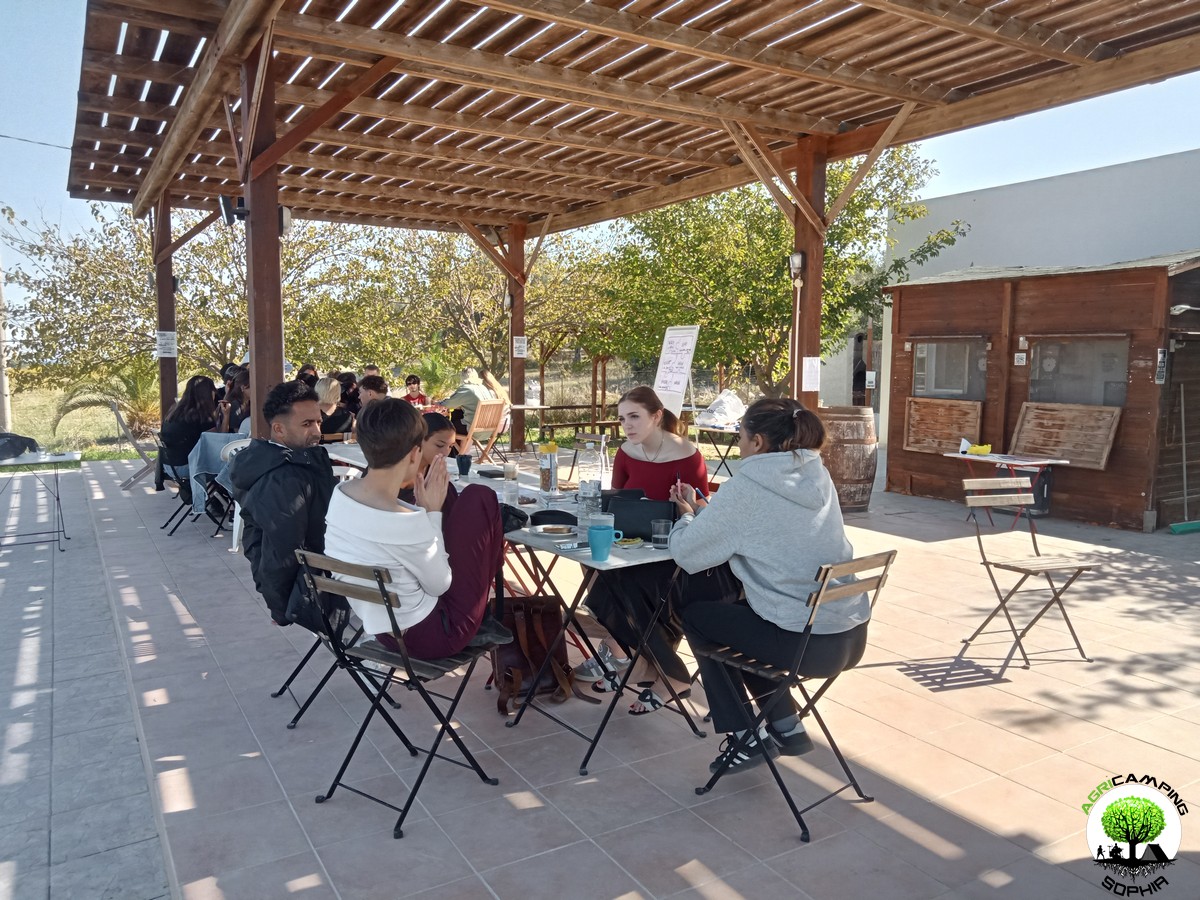 DO YOU WANT TO ORGANIZE AN ERASMUS AT AGRICAMPING SOPHIA?
DO YOU WANT TO ORGANIZE AN ERASMUS AT AGRICAMPING SOPHIA?
WHAT IS AGRICAMPING SOPHIA?
It is a campsite with tent pitches, glamping tents, mobile homes and bungalows
WHERE IS IT?
In Italy, in Sicily, near Syracuse, in Pachino: 36.736883, 15.095610
HOW TO CONTACT US?
info@agricampingsophia.it
(SPEAK ENGLISH) +39 3473079242 – (ONLY SPEAK ITALIAN) +39 3452396095
WHAT DO WE OFFER?
We offer hospitality and catering for Erasmus projects
FOR HOW MANY PEOPLE?
We can have 4-7 single beds in the Socrate Bungalow, 6-10 single beds in the Platone Mobile Homes, 4-6 single beds in the Aristotele Mobile Homes, 4 single beds in the Iblone Mobile Homes, 4 single beds in the single beds in the Empedocle Glamping Tents. In total we therefore have 18 comfortable single places or 31 single places with a fair spirit of adaptation.
IN WHICH PERIOD CAN AGRICAMPING SOPHIA BE AVAILABLE?
The most suitable periods to use our services...
 CART RUTS MODELED ON SOFT ROCK?
CART RUTS MODELED ON SOFT ROCK?
Read also RACK OR HOUSING FOR CLOGS?
Some cart ruts from the Targia district, in Syracuse, and most of the cart ruts from Granatari Vecchi, in Rosolini, give the impression of having been impressed, modelled, on a rock that was originally viscous, not entirely solid. As absurd as this hypothesis may seem, especially in Granatari Vecchi, the softness of the shapes and the at least anomalous uniformity of the rock bank, as if it were a concrete casting, which hosts the cart ruts, is unicum compared to the lithic context in the area.
In Targia this phenomenon is less impressive but if we consider the cart ruts essentially cart tracks, therefore furrowed roads indirectly resulting from the repeated passage of carts along the same route, we do not understand why such uniformity and smoothness is present, in the majority of cases, also on the parts not affected by the passage of the...
 RACK OR HOUSING FOR CLOGS?
RACK OR HOUSING FOR CLOGS?
Read also CART RUTS CUT FROM QUARRIES
In the presence of slopes, even slight ones, in some cart ruts in the Targia district, in Syracuse, central holes are found with a diameter of between 30 and 50 centimeters and a depth of 15-20 centimeters, spaced about 50 centimeters apart. Neither the position (they are not exactly in the center of the cart ruts and perfectly aligned with each other), nor the shape appear perfectly regular: either the passage of time and any wear have profoundly modified their original shape or, simply, they have never had a systematic regularity. However, the offset in position between one hole and another is never completely “off-axis”: there is always a portion about twenty centimeters wide that coincides with the same portion of the previous and subsequent hole. The best preserved and most defined holes are found in the cart ruts usually called Scala...
 CART RUTS CUT FROM QUARRIES
CART RUTS CUT FROM QUARRIES
Back to CART RUTS AND A FEW TOO MANY PROJECTIONS
I will skip any preamble, referring to what has already been written regarding the presence of cart ruts in south-eastern Sicily.
The easy academic tendency has been, in most cases concerning cart ruts, to consider them in terms of the latomie, or quarries, with which very often (for example in the cases of the Targia or Pizzuta districts) they share the same territory.
According to this theory, the carraie would have been indirectly created due to the wear of the rock at each passage of carts or sleds loaded with extracted stone blocks. I will not repeat the arguments presented so far in order to demonstrate that this is a theory that has little solid foundations on an in-depth analysis of the cart ruts. However, I will add a piece by demonstrating the implausibility of a connection between them in both chronological and functional...
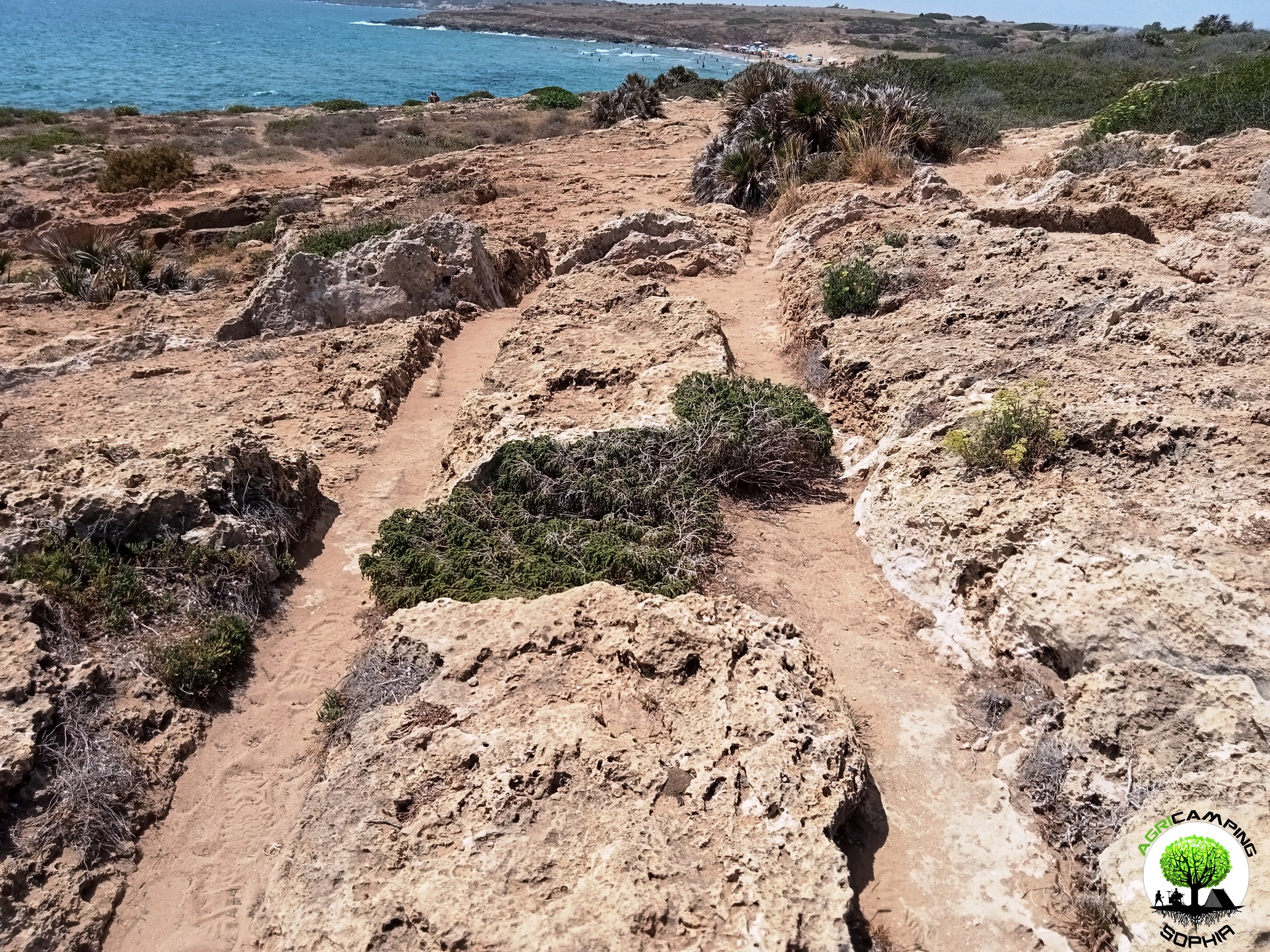 CART RUTS AND A FEW TOO MANY PROJECTIONS
CART RUTS AND A FEW TOO MANY PROJECTIONS
Read also THE POLISHING OF THE CART RUTS
I will skip any preamble, referring to to what has already been written regarding the presence of cart ruts in south-eastern Sicily.Considering the possibility that the cart ruts were gradually dug by the passage of carts pulled by pack animals, for example pairs of oxen, observing certain sections of the cart ruts present in the Granatari Vecchi district, in Rosolini, and in the Pizzuta district, close to the Vendicari Reserve, two questions arise:
1. Why force the animals to pass over rough surfaces and protrusions high, compared to the base of the furrows, even 60-70 centimeters?
2. Why, in the presence of such obstacles, not opt for a detour?
For Mottershead, Pearson and Schaefer such protrusions appeared later, since at the time of the passage of the wagons, a layer of earth covered the rocky bank, thus not making the obstacle...
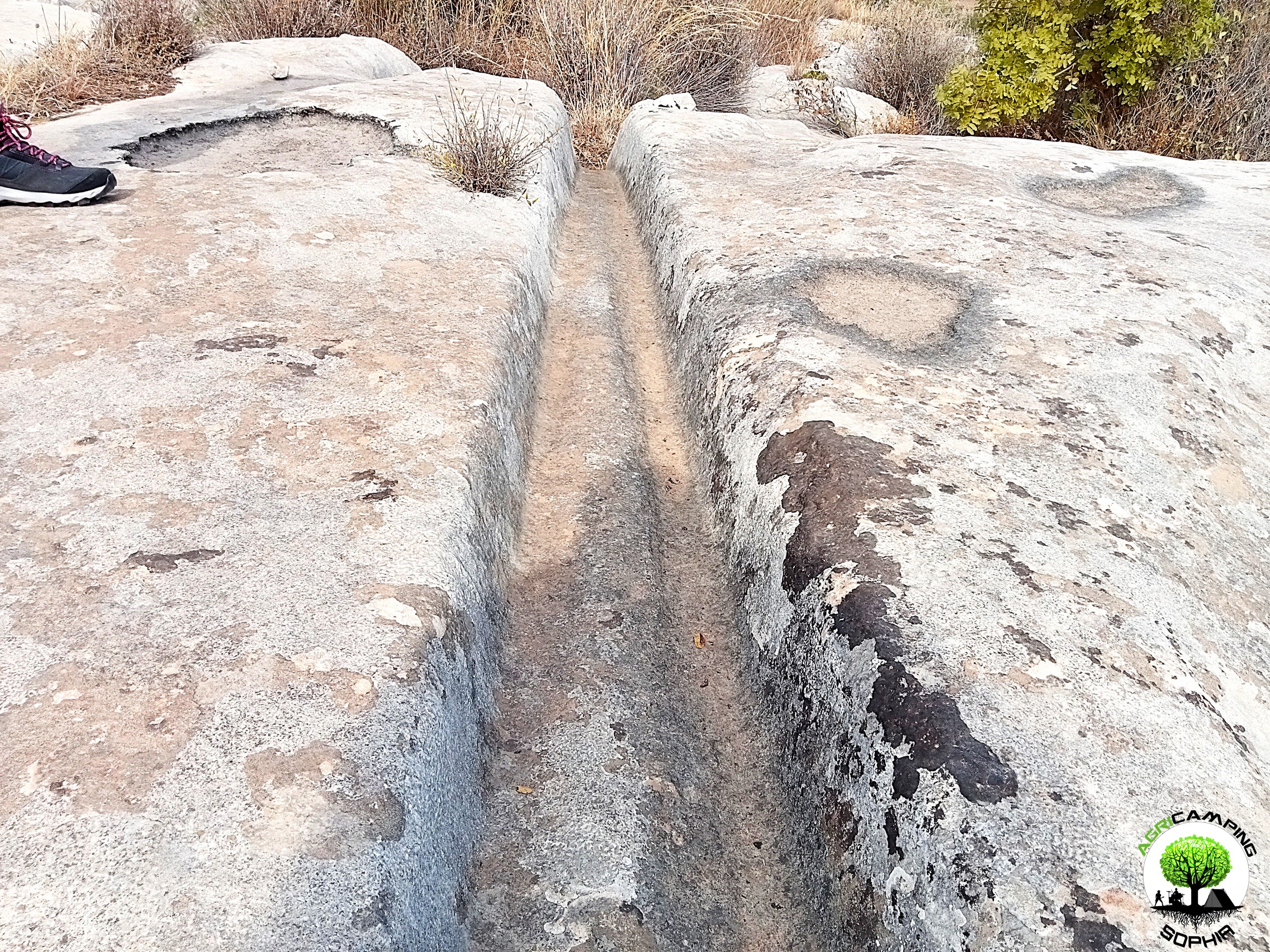 THE POLISHING OF THE CART RUTS
THE POLISHING OF THE CART RUTS
Read also THE PROBLEMATIC EDGES OF THE CART RUTS
I will skip any preamble, referring to to what has already been written regarding the presence of cart ruts in south-eastern Sicily.
To proceed with this comparison I have chosen a probable capital and the corner of a recess present in a block of the northern walls of Eloro that would seem to resemble a pinax, that is, a niche that would have housed a fresco of the heroa, but which a more careful observation refers to a system functional to the grip of the block through a pincer winch. Both elements, like the curt ruts, have remained at the mercy of the elements for millennia, and are therefore subject to comparable wear and tear due to the passage of time. The finishing of the capital should be of a high standard, since it is an architectural element that also has an aesthetic function. The recess, on the other hand, should have...
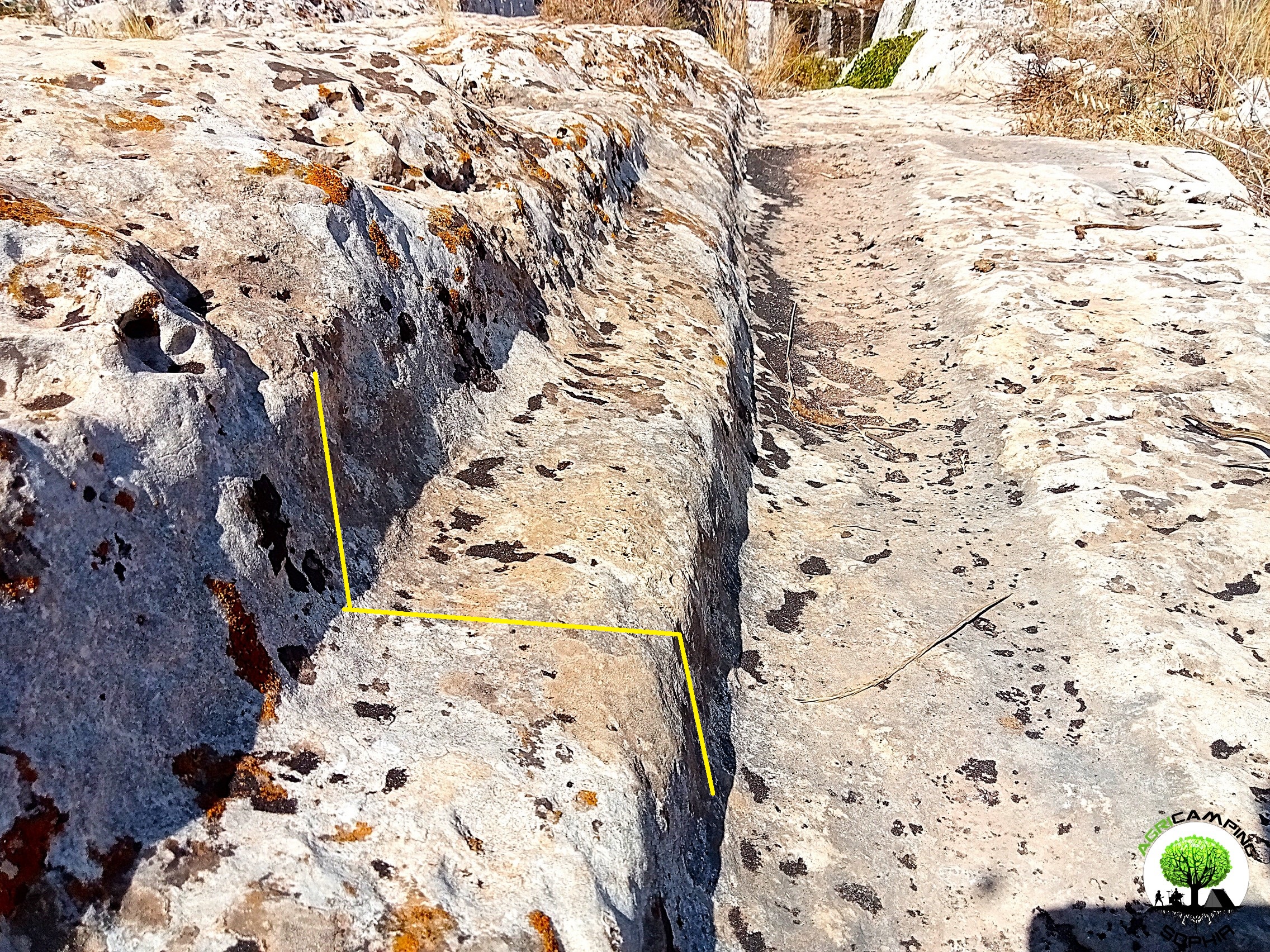 THE PROBLEMATIC EDGES OF THE CART RUTS
THE PROBLEMATIC EDGES OF THE CART RUTS
I will skip any preamble, referring to to what has already been written regarding the presence of cart ruts in south-eastern Sicily.As can be seen in other sites around the world, in some cart ruts I visited, in particular in the Cugni district in Pachino, in the Granati Vecchi district in Rosolini and in the Targia district in Syracuse, a clear border can be seen, a sort of frame, next to the grooves, more marked externally, barely noticeable internally.
The borders I measured have a width of 14-20 centimeters and a height of 8-10 centimeters.
Not all cart ruts have such frames present or particularly evident, regardless of the degree of wear or degradation. They are found above all in cart ruts with less deep grooves.
As already described in detail, given the presence of furrows with a depth of even 65-70 centimeters, the wheels of a possible vehicle would have had to have a...
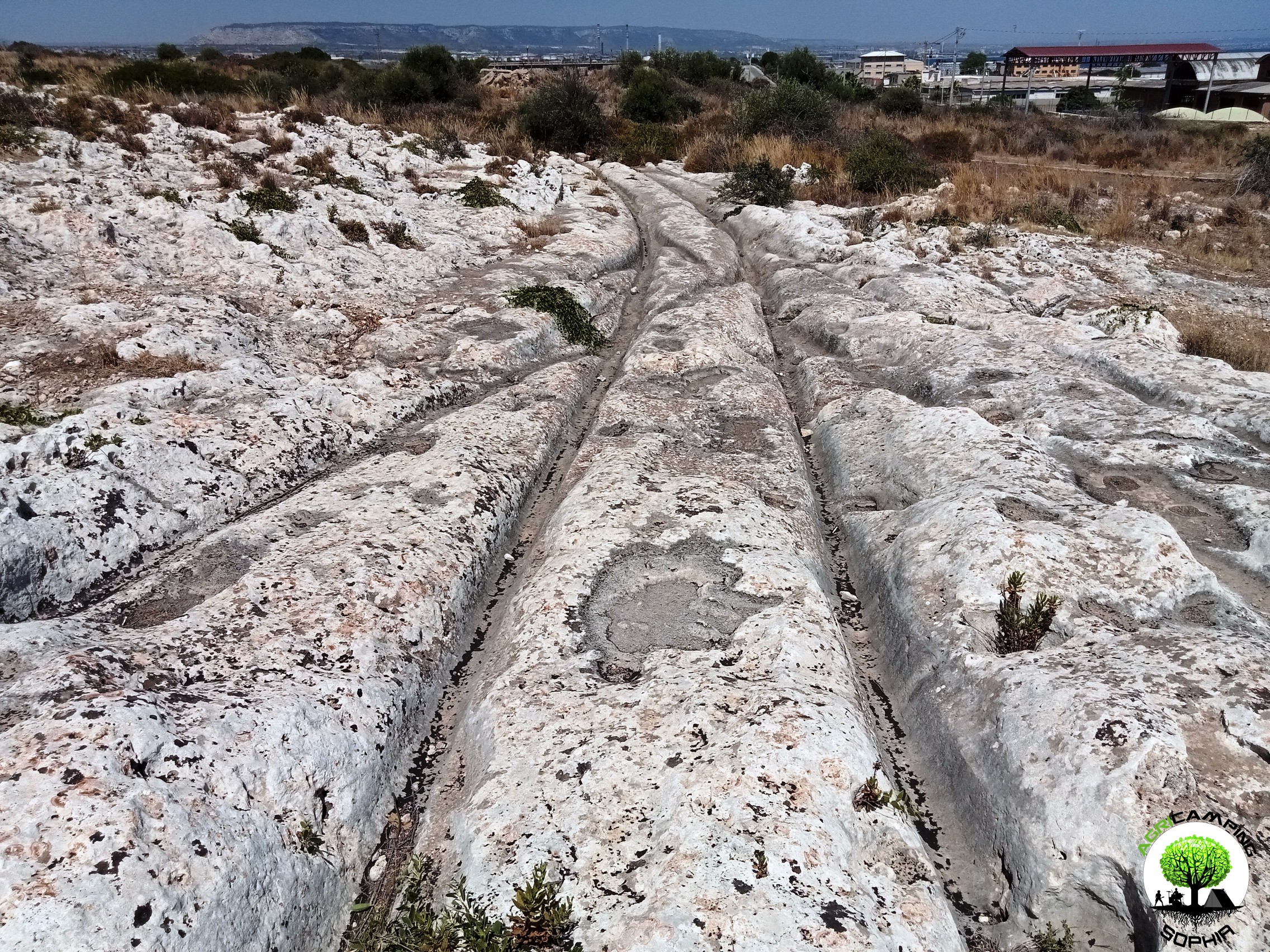 THE PROBLEM OF CART RUTS IN SOUTH-EASTERN SICILY (PART FOUR)
THE PROBLEM OF CART RUTS IN SOUTH-EASTERN SICILY (PART FOUR)
Click here to return to third part
Clapham Junction
As in the Maltese site Misrah Ghar Il-Kbir, also in the Targia and Granatari Vecchi districts the cart ruts intersect and cross each other in a similar way to the track switches in a railway station. The nickname Clapham Junction that was given by David H. Trump to the Maltese site, derives precisely from the similarity with the famous English railway station. For Sagona these are agricultural furrows and water channels, for Mottershead, Pearson and Schaefer these are abandoned paths due to obstacles and wear. Obviously we do not know what the morphology of the Syracuse and Rosolini territory was at times when the cart ruts were traced, but considering the current context, there certainly would have been no agricultural reason to build them, given the presence of fertile land, springs and fresh water courses just a few kilometers...



 DO YOU WANT TO ORGANIZE AN ERASMUS AT AGRICAMPING SOPHIA?
DO YOU WANT TO ORGANIZE AN ERASMUS AT AGRICAMPING SOPHIA? CART RUTS MODELED ON SOFT ROCK?
CART RUTS MODELED ON SOFT ROCK? RACK OR HOUSING FOR CLOGS?
RACK OR HOUSING FOR CLOGS? CART RUTS CUT FROM QUARRIES
CART RUTS CUT FROM QUARRIES CART RUTS AND A FEW TOO MANY PROJECTIONS
CART RUTS AND A FEW TOO MANY PROJECTIONS THE POLISHING OF THE CART RUTS
THE POLISHING OF THE CART RUTS THE PROBLEMATIC EDGES OF THE CART RUTS
THE PROBLEMATIC EDGES OF THE CART RUTS THE PROBLEM OF CART RUTS IN SOUTH-EASTERN SICILY (PART FOUR)
THE PROBLEM OF CART RUTS IN SOUTH-EASTERN SICILY (PART FOUR)